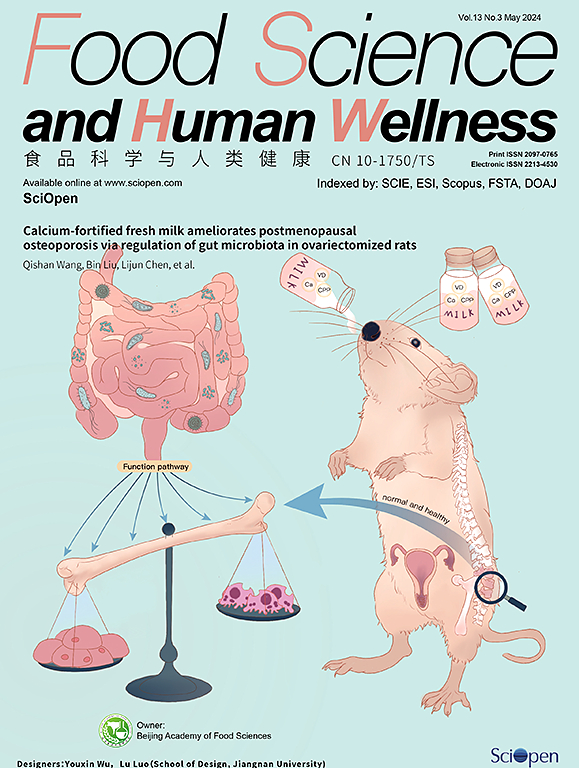A novel fluorescence sensor for milk clotting enzyme chymosin using peptide as substrate and covalent organic framework nanosheet as fluorescence quencher
IF 7.4
1区 农林科学
Q1 FOOD SCIENCE & TECHNOLOGY
引用次数: 0
Abstract
Chymosin is one of the critical enzymes in cheese making. Herein, we proposed a novel fluorometric assay for chymosin determination. Firstly, covalent organic frameworks (COF) were synthesized and exfoliated to 2-dimensional COF nanosheets (COF NS) by ultrasound treatment. Gold nanoparticles (Au NPs) were loaded with COF NS to prepare AuNPs/COF NS (Au@COF NS). Secondly, rhodamine B (RhB) modified substrate peptide (Pep) for chymosin was linked with Au@COF NS to construct a Pep-Au@COF NS nanocomposite. For the sensing principle, fluorescence of RhB was quenched by Au@COF NS and the fluorescence intensity was weak due to the fluorescence resonance energy transfer between COF NS and RhB of Pep. However, in the presence of chymosin, the RhB was released by specific cleavage of the substrate peptide by chymosin and resulted in the recovery of fluorescence. The increased fluorescence intensity was proportional to the increase of chymosin concentration and thus a “turn on” fluorescent sensor for chymosin was constructed. The sensor showed a linear range in the concentration of 0.05![]() 60.00 μg/mL for the detection of chymosin with a detection limit of 20 ng/mL. The sensor was used to quantify chymosin in rennet product with good selectivity, which has the potential applications in cheese manufacturing.
60.00 μg/mL for the detection of chymosin with a detection limit of 20 ng/mL. The sensor was used to quantify chymosin in rennet product with good selectivity, which has the potential applications in cheese manufacturing.

以肽为底物、共价有机框架纳米片为荧光淬灭剂的新型牛奶凝血酶糜蛋白酶荧光传感器
凝乳酶是奶酪制作过程中的关键酶之一。在此,我们提出了一种新的荧光法测定凝血酶。首先合成共价有机骨架(COF),并通过超声处理将其剥离成二维COF纳米片(COF NS);利用金纳米粒子(Au NPs)负载COF NS制备AuNPs/COF NS (Au@COF NS)。其次,将罗丹明B (RhB)修饰的凝乳酶底物肽(Pep)与Au@COF NS连接,构建Pep-Au@COF NS纳米复合材料。传感原理为Au@COF NS猝灭RhB的荧光,由于COF NS与Pep的RhB之间的荧光共振能量转移,导致荧光强度较弱。然而,当有凝乳酶存在时,RhB被凝乳酶特异性裂解底物肽释放,导致荧光恢复。荧光强度的增加与凝乳酶浓度的增加成正比,因此构建了一个“打开”的凝乳酶荧光传感器。该传感器对凝血酶的检测在0.0560.00 μg/mL呈线性范围,检测限为20 ng/mL。该传感器用于定量凝血酶产品中的凝乳酶,具有良好的选择性,在奶酪生产中具有潜在的应用前景。
本文章由计算机程序翻译,如有差异,请以英文原文为准。
求助全文
约1分钟内获得全文
求助全文
来源期刊

Food Science and Human Wellness
Agricultural and Biological Sciences-Food Science
CiteScore
8.30
自引率
5.70%
发文量
80
审稿时长
28 days
期刊介绍:
Food Science and Human Wellness is an international peer-reviewed journal that provides a forum for the dissemination of the latest scientific results in food science, nutriology, immunology and cross-field research. Articles must present information that is novel, has high impact and interest, and is of high scientific quality. By their effort, it has been developed to promote the public awareness on diet, advocate healthy diet, reduce the harm caused by unreasonable dietary habit, and directs healthy food development for food industrial producers.
文献相关原料
公司名称
产品信息
阿拉丁
chymosin
阿拉丁
ascorbic acid
阿拉丁
sodium citrate
阿拉丁
Chloroauric acid hydrate
 求助内容:
求助内容: 应助结果提醒方式:
应助结果提醒方式:


